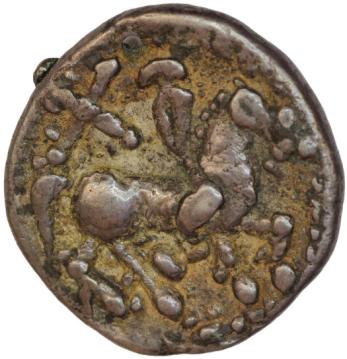Iron Age
The Dengie area was part of
the territory of the Trinovantes tribe who controlled an area
similar to that of modern Essex.
Asheldham was an important
Iron Age site with a Fort constructed with embankments and a
settlement. Many Iron age items have been found in the immediate
vicinity. The fort was probably built in the 5th century BC and
still in good enough condition to be used as a fort by the Saxons
several hundred years later.

Site of Asheldham Camp
Excavations at Asheldham have
found flint work from the neolithic/bronze age although the most
valuable finds to date are a pottery vessel that has been dated to
between 4000BC to 2351BC and a Saxon Burial Urn. Perhaps more
surprisingly Roman and early medieval pottery remains have also been
found on this site. Excavated material is held at Colchester Castle
Museum.
An excavation in 1930
uncovered an iron age burial site to the south of the present
railway track 350 yards from Burnham Railway Station. Pottery
recovered includes a butt-beaker of dark brown ware, a large jug of
red ware, a pedestal urn of brown ware and a gallo-belgic platter of
grey ware.
In the second century BC newcomers from France moved into the area to live at peace with the Trinovantes. The newcomers were known as the Belgae. They brought with them many new skills and customs including the introduction of gold coins and wheel made pottery.
The Belgae improved the fort
at Asheldham and established a settlement and a cemetery at Burnham
on Crouch.
One of the main industries of
the area was salt panning. Pits were dig on the foreshore near to
the tidal limit and lined with clay. Sea water was allowed to flow
into these pits and then the pits were closed to the sea. Nature was
then allowed to work and evaporate the water leaving a deposit of
concentrated brine. This brine was transferred into earthenware pots
and dried off on fires. The accumulating earthenware and burnt clay
was thrown to one side. After years of salt production these waste
areas grew in size and are now called red hills due to the red
colour of both fired clay and earthenware. The Dengie area was an
important area for salt production and red hills are still evident
in several places. The trade continued until later roman times when
improved techniques were introduced.
The invasion of Britain in AD
43 was fiercely resisted by the Trinovantes who were subject to
harsh rule by the Romans in comparison to more favourable treatment
on neighbouring tribes who surrendered to the Romans.
The treatment was so harsh
that in AD 60 the Trinovantes and the Iceni under Queen Boudicca
revolted and destroyed the depleted 9th Roman Division before
sacking Camulodunum (Colchester). A Roman arm under British Governor
Suetonious Paulinus defeated Boudicca in the late summer of AD60
with a massacre of the tribesmen.
The Roman Response was so
severe that the Trinovantes name disappeared never to appear in the
history books again.
Items recovered
include
 Coin
found at Latchingdon on display in the
British Museum
Coin
found at Latchingdon on display in the
British Museum
Mundon - Iron
age pottery found in red hill
Bradwell on Sea - Remains of
twelve oak posts which appear to be the base of a structure. The
posts show signs of being cut with a iron implement.
Creeksea - An
iron age burial area with several urns recovered



